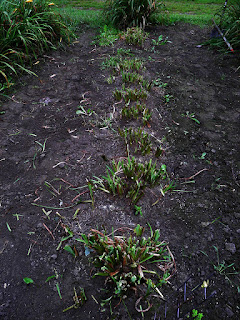Friday, October 21, 2016
A quiet morning here on the mountain. I have the truck packed and am about ready to head for the flower farm for what might be the final day of planting. We have been hard at it for a couple-three weeks now, digging and dividing perennials to replace what we sold out of this summer. Our recent focus was on daylilies although we have moved through trollius and hostas too. Yesterday Gail and Alex managed to find a few hours to plant a new hydrangea garden and that will look really nice next summer.
I started the garden 6 weeks ago by getting a new plot started parallel to Route 2. We wanted a garden with some visibility from the road but also close enough to the parking area that visitors and customers could quickly walk to it and see mature specimens of the various paniculata hydrangeas we sell. The garden turned out to be about 85 feet long and 5 feet wide. The first ten feet closest to the entrance was solid clay and for now, we will avoid it. I'll work in some leaves and some gypsum over the next couple weeks and use that space for annuals like zinnias next summer. Since all our land was at the bottom of the Winooski Ocean 15,000 years ago, it's no surprise to find clay.
Alex asked for instructions and off he went, doing most of the project himself. If you know Alex,you know that he handles jobs a piece at a time. I always tell him what we're going to do a day ahead if possible and then repeat it the day we're doing a project. In this case, I explained what items we had to get ready and then the timeline. He got it right the first time and as soon as he and Gail got all the pots placed, he started digging and went on from there.
It kind of bothers me when I hear stories about people starting jobs and "not working out" when more often than not the "not working out" means the whoever is supposed to be supervising them on the job might be overloading with lists of things to do even before clear training of the basics has been provided. America has some great employees out there....but..... Some are young and probably not experienced and could even have learning disabilities; others could be seniors who need a job, have good skills but need explanations and maybe reminders. As good managers and good friends, we need to remember this. Everyone has talents and with some it takes a little more time for them to develop.
Start to finish the planting was completed in under three hours and it looks clean as a whistle. It will require another three years for the hydrangeas to get closer to their mature size but the shape, height and width, and the flower size and colors will be obvious next season. If you drive around Vermont you'll notice that many older houses and farms have wonderful specimens of hydrangeas, some of which have probably been in place since they were built. Based on the number of hydrangeas we sell every year, it's clear that many people like them.
Writing from the mountain above Peacham Pond but now heading to the valley for some planting. If you drive by and see the gates open, stop in and say hello. We always have time to learn about your gardens and answer questions if we can.
George Africa
The Vermont Gardener
Always here to help you grow your green thumb!










